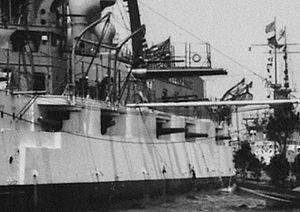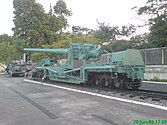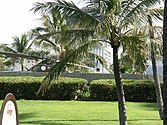
Joint Expeditionary Base-Fort Story, commonly called simply Fort Story is a sub-installation of Joint Expeditionary Base Little Creek–Fort Story, which is operated by the United States Navy. Located in the independent city of Virginia Beach, Virginia at Cape Henry at the entrance of the Chesapeake Bay, it offers a unique combination of features including dunes, beaches, sand, surf, deep-water anchorage, variable tide conditions, maritime forest and open land. The base is the prime location and training environment for both U.S. Army amphibious operations and Joint Logistics-Over-the-Shore (LOTS) training events.

The 3-inch gun M1918 was a United States 3-inch anti-aircraft gun that entered service in 1918 and served until it was largely superseded by the 3-inch anti-aircraft gun M3 in 1930, though the M1918 remained with some National Guard units until early in World War II. The M3 was subsequently replaced by the M1 90mm AA gun early in World War II, primarily during 1942. The M3 3" gun was later adapted for the anti-tank role, serving as the main armament of the M10 tank destroyer during World War II.

The 16 inch gun M1919 (406 mm) was a large coastal artillery piece installed to defend the United States' major seaports between 1920 and 1946. It was operated by the United States Army Coast Artillery Corps. Only a small number were produced and only seven were mounted; in 1922 and 1940 the US Navy surplussed a number of their own 16-inch/50 guns, which were mated to modified M1919 carriages and filled the need for additional weapons.
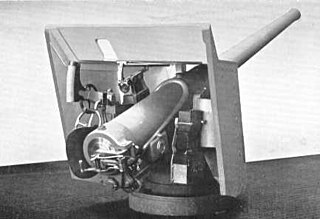
The QF 4.7-inch Gun Mks I, II, III, and IV were a family of British quick-firing 4.724-inch (120 mm) naval and coast defence guns of the late 1880s and 1890s that served with the navies of various countries. They were also mounted on various wheeled carriages to provide the British Army with a long range gun. They all had a barrel of 40 calibres length.
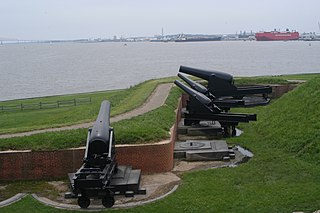
Seacoast defense was a major concern for the United States from its independence until World War II. Before airplanes, many of America's enemies could only reach it from the sea, making coastal forts an economical alternative to standing armies or a large navy. After the 1940s, it was recognized that fixed fortifications were obsolete and ineffective against aircraft and missiles. However, in prior eras foreign fleets were a realistic threat, and substantial fortifications were built at key locations, especially protecting major harbors.

The 4″/50 caliber gun was the standard low-angle, quick-firing gun for United States, first appearing on the monitor Arkansas and then used on "Flush Deck" destroyers through World War I and the 1920s. It was also the standard deck gun on S-class submarines, and was used to rearm numerous submarines built with 3-inch (76 mm) guns early in World War II. United States naval gun terminology indicates the gun fired a projectile 4 inches in diameter, and the barrel was 50 calibers long.
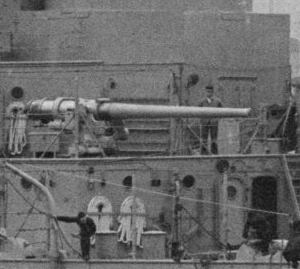
5"/51 caliber guns initially served as the secondary battery of United States Navy battleships built from 1907 through the 1920s, also serving on other vessels. United States naval gun terminology indicates the gun fired a projectile 5-inch (127 mm) in diameter, and the barrel was 51 calibers long.
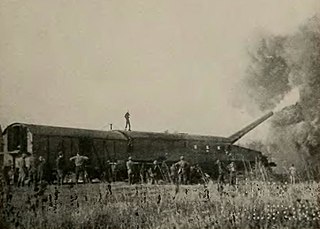
The 14"/50 caliber railway guns were spare US Navy Mk 4 14 inch/50 caliber guns mounted on railway cars and operated by US Navy crews in France in the closing months of World War I.

The 16"/50 caliber Mark 2 gun and the near-identical Mark 3 were guns originally designed and built for the United States Navy as the main armament for the South Dakota-class battleships and Lexington-class battlecruisers. The successors to the 16"/45 caliber gun Mark I gun, they were at the time among the heaviest guns built for use as naval artillery.
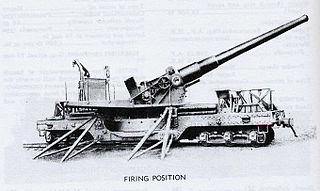
The 8-inch Navy gun Mk.VI M3A2 on railway mount M1A1 was a World War II improved replacement for the World War I-era 8-inch M1888 gun and was used by the US Army's Coast Artillery Corps in US harbor defenses. The guns were also mounted in fixed emplacements on the barbette carriage M1A1. These guns were US Navy surplus 8"/45 caliber guns from battleships scrapped under the 1922 Washington Naval Treaty. Mark VI was the Navy designation. The Army designation for this gun was "8-inch Navy gun Mk.VI M3A2".

The 12-inch coast defense mortar was a weapon of 12-inch (305 mm) caliber emplaced during the 1890s and early 20th century to defend US harbors from seaborne attack. In 1886, when the Endicott Board set forth its initial plan for upgrading the coast defenses of the United States, it relied primarily on mortars, not guns, to defend American harbors. Over the years, provision was made for fortifications that would mount some 476 of these weapons, although not all of these tubes were installed. Ninety-one of these weapons were remounted as railway artillery in 1918-1919, but this was too late to see action in World War I. The railway mortars were only deployed in small quantities, and none overseas. The fixed mortars in the Philippines saw action in the Japanese invasion in World War II. All of the fixed mortars in the United States were scrapped by 1944, as new weapons replaced them, and the railway mortars were scrapped after the war. Today, the only remaining mortars of this type in the 50 states are four at Battery Laidley, part of Fort Desoto near St. Petersburg, Florida, but the remains of coast defense mortar emplacements can be seen at many former Coast Artillery forts across the United States and its former territories. Additional 12-inch mortars and other large-caliber weapons remain in the Philippines.

The 8-inch gun M1888 (203 mm) was a U.S. Army Coast Artillery Corps gun, initially deployed 1898–1908 in about 75 fixed emplacements, usually on a disappearing carriage. During World War I, 37 or 47 of these weapons were removed from fixed emplacements or from storage to create a railway gun version, the 8-inch Gun M1888MIA1 Barbette carriage M1918 on railway car M1918MI, converted from the fixed coast defense mountings and used during World War I and World War II.

The U.S. Army Coast Artillery Corps (CAC) was an administrative corps responsible for coastal, harbor, and anti-aircraft defense of the United States and its possessions between 1901 and 1950. The CAC also operated heavy and railway artillery during World War I.

The 12-inch coastal defense gun M1895 (305 mm) and its variants the M1888 and M1900 were large coastal artillery pieces installed to defend major American seaports between 1895 and 1945. For most of their history they were operated by the United States Army Coast Artillery Corps. Most were installed on disappearing carriages, with early installations on low-angle barbette mountings. From 1919, 19 long-range two-gun batteries were built using the M1895 on an M1917 long-range barbette carriage. Almost all of the weapons not in the Philippines were scrapped during and after World War II.

The 10-inch Gun M1895 (254 mm) and its variants the M1888 and M1900 were large coastal artillery pieces installed to defend major American seaports between 1895 and 1945. For most of their history they were operated by the United States Army Coast Artillery Corps. Most were installed on disappearing carriages, with early installations on barbette mountings. All of the weapons not in the Philippines were scrapped during World War II. Two of the surviving weapons were relocated from the Philippines to Fort Casey in Washington state in the 1960s.

The 14-inch Gun M1907 (356 mm) and its variants the M1907MI, M1909, and M1910 were large coastal artillery pieces installed to defend major American seaports between 1895 and 1945. They were operated by the United States Army Coast Artillery Corps. Most were installed on single gun disappearing carriages; the only installation with four guns in twin turrets was built at the unique Fort Drum in Manila Bay, Philippines. All of the weapons not in the Philippines were scrapped during World War II.
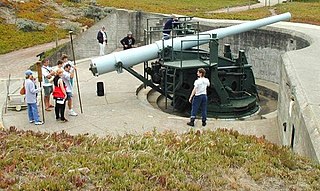
The 6-inch gun M1897 (152 mm) and its variants the M1900, M1903, M1905, M1908, and M1 were coastal artillery pieces installed to defend major American seaports between 1897 and 1945. For most of their history they were operated by the United States Army Coast Artillery Corps. They were installed on disappearing carriages or pedestal mountings, and during World War II many were remounted on shielded barbette carriages. Most of the weapons not in the Philippines were scrapped within a few years after World War II.

The 8"/45 caliber Mark 6 gun were used for the secondary batteries of the United States Navy's last pre-dreadnought battleships and refitted in older armored cruisers main batteries.

The 4"/40 caliber gun was used for the secondary batteries on the United States Navy's battleship Iowa, Columbia-class protected cruisers, and the armored cruiser New York, and was the primary batteries on the gunboats Nashville, Wilmington, and Helena.

The 6"/50 caliber gun Mark 6 and Mark 8 were used for the secondary batteries of the United States Navy's Maine-class and Virginia-class battleships, as well as the Pennsylvania-class and Tennessee-class armored cruisers. They were also used as the main battery on the St. Louis-class protected cruisers.
